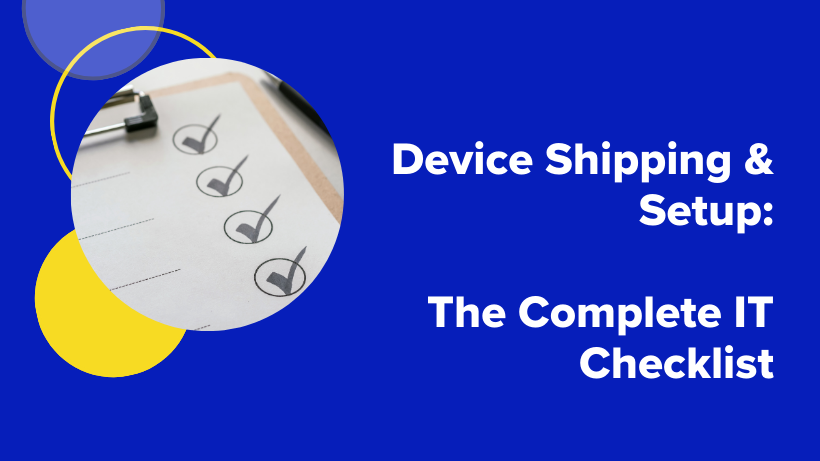Securing Remote Work: Essential IT Checklist for Device Setup and Shipping

The adoption of remote work has been steadily ramping up as employees discover the benefits of working from home (WFH), with some of them now seeing this as a must-have criterion when choosing where to work. Just a few of the perks include not having to commute, a quiet space more attuned to tasks that require intense concentration, and the time flexibility to pick up kids from school or take them to the dentist. Businesses are happy to keep up with the trend because they have the freedom to choose new hires or contractors from a global talent pool, are delighted to keep their workers satisfied and are keen to save costs for power consumption, cleaning and parking spaces. Many are even cutting down on office space by implementing a hot-seat policy.
One study shows that by early 2023, about 30% of work days were being done from home, usually as part of a hybrid WFH policy. 1
As companies define and refine better remote work policies, this trend is expected to grow steadily in popularity.
But working from home opens up a whole new can of worms, with challenges that can stump even seasoned IT teams. Providing employees with the technology they need and making sure it works properly from remote locations can be daunting. It also brings with it added cybersecurity risks since home networks are typically less secure than office environments.
IT departments are not generally geared up to impose security measures on personal devices. For this reason, many set up and send out a company computer to remote employees, with the understanding that all company work will be done on this company device—to help isolate and manage the security issues.
If you’re wondering how to:
- Set up and ship a secure device that can be used by remote employees
- Ensure security measures are in place to block the exposure of company data
- Get employees onboarded & working immediately, then
This blog is for you.
Your Comprehensive Device Shipping Checklist
There are a lot of things to consider before you start shipping out equipment, especially because this involves safeguarding your organization’s assets and reputation while complying with data protection regulations.
Having a comprehensive checklist for shipping these devices can save you a lot of time and money. Following the checklist below can help you avoid glitches and snafus in advance.
Step 1: Pre-Shipment Preparation – Decide How You Will Equip Your Remote Employees
You’ll need a clear equipment policy with guidelines on how to outfit your new hires—in terms of devices, hardware components, software installations and updates. This will let you optimize what you spend and how you spend it. What’s more, your employees will be happy to know in advance what they get as part of their WFH package.
- Device selection – There’s no magic recipe for how to budget, but companies often use job role requirements to align equipment needs. For example, a senior animator will need a laptop with more processing power than someone in HR. You might also want to take into consideration whether the role has high turnover rates and the fact that some employees may not return their devices.
- In addition, decide whether you’ll be giving each worker an allowance to spend on hardware components like chargers, adapters, keyboard, monitor or earbuds, or providing a standard kit of accessories for everyone that will also need to be shipped.
- Software installation and updates – Nobody wants to spend their first few days of a new job downloading apps and waiting for updates to run, so you’ll need to set up the devices before shipping them. Because home networks are often less secure, leaving the installation of security applications up to each employee could mean exposure to cyberattacks.
- Pre-install all necessary software, applications and tools so your new hires get their devices ready to use and can happily start being productive right away. You will also be more relaxed when it comes to security concerns.
- Update all application software to the latest versions. This is critical for several reasons. First, updates often include important security patches that protect the devices against known vulnerabilities and cyber threats. Second, updated software usually offers improved features and better compatibility with other tools and applications that enhance productivity and reduce technical issues.
- Install security software and updates. These remote devices essentially form a line of defense for company data. Pre-installing antivirus and anti-malware software will protect the device from malicious software that can compromise data or device functionality.
- Security protocols – Implementing robust security protocols will safeguard both the integrity of the device and its data.
- Encrypt hard drives to protect the data from unauthorized access in case the device is lost or stolen—whether en route or once at its remote destination.
- Install VPN and endpoint protection solutions to secure the connection between the remote worker’s device and your company network. In this way, any data transmitted over the internet is encrypted and safe from interception.
- Configure pre-boot authentication and BIOS settings to prevent unauthorized programs from loading during the device’s startup process so only trusted software runs on the device.
- Establish remote wipe capability so your team can remotely erase the data on a device if it’s lost or stolen, or if the worker is let go.
- User access – Strict access controls will limit use of the device and its data to authorized personnel.
- Set up appropriate user accounts and permissions in advance to minimize the risk of data breach.
- Adjust any accessibility settings based on employee job requirements. For example, do you need to put limitations on what data employees can only access, or prevent actions like taking screenshots or printing based on their job requirements.
Step 2: Packaging and Shipping – How to Avoid Extra Expenses and Lost Productivity
- Secure packaging will protect the device from physical damage like impact or drops during transit.
- Choose the right packaging materials to prevent damage during transit. Skimping on packing can lead to damaged hardware including cracked screens and dislodged components, adding costly repairs or replacements and delays to the picture.
- Keep sustainability in mind and remember that shipping devices to employees also has environmental impacts, including the fuel used by vehicles transporting the devices and the packaging that is used to protect them — which is often discarded afterward. See whether reusable or recycled packing is a viable option.
- Labeling and documentation should include all the setup instructions, warranty information and user guides employees need to set up the device.
- Correctly label packages to ensure privacy and security, as well as correct handling during shipping to prevent damage.
- Include all necessary setup instructions and welcome documents. Missing or unclear documentation can lead to improper setup of the device, possibly causing delays and frustration for the employee—alongside frantic calls to the IT team.
- Choosing a reliable shipping vendor is critical for dependability, tracking capabilities, and service quality.
- Look for a shipping vendor that can deliver within the required timeframes and knows how to handle sensitive electronic devices. Double-check that their cost model and geographical coverage match your needs, especially if your workforce is spread globally.
- Verify their tracking capabilities and insurance options. Do they offer comprehensive insurance and liability coverage to protect against loss or damage? Any vendor should include tracking so you can monitor the package until it safely reaches the employee.
Step 3: Post-Shipment Support – Proactive Planning Will Help Employees Get Up and Running Smoothly
- Initial setup support—whether through virtual onboarding sessions or responsive IT teams—is a must to address potential setup issues. Any delays that prevent employees from becoming operational can lead to frustration, reduced productivity and aggravated employees.
- Provide remote support for initial device setup and troubleshooting. Make real-time assistance available via phone or video to help employees configure their devices and avoid common setup errors.
- Schedule virtual onboarding sessions to guide employees through the setup process. These sessions should provide step-by-step guidance and answer common questions, giving employees a positive transition to the new equipment.
- Ongoing IT support should be a streamlined process to minimize downtime.
- Establish dedicated IT channels, such as helpdesk software or direct chat, to give remote workers a timely and clear path to solving IT issues.
- Use remote management tools to support employees and perform routine maintenance. These will allow you to troubleshoot problems, update software and perform maintenance—while maintaining security.
- Determine whether you need dedicated personnel from the IT team to ensure employee success. Having someone available to help remote employees should be a top priority.
- If the shipment isn’t properly tracked, or if the internal documentation is unclear, there could be confusion about the location of the device or its configuration. Ultimately this translates into more troubleshooting, losses if devices go missing, and inventory discrepancies.
- Build a feedback loop to address recurring issues connected with device setup and delivery.
- Encourage feedback on the device setup and shipping process. After the setup, request feedback from employees about their experience to identify areas in the process that can be improved.
- Use the feedback to improve future shipments. By refining and optimizing the setup and shipping processes based on real user experience, you’ll be able to enhance efficiency and employee satisfaction for future deployments.
Step 4: Returns – Set Up a Secure Process to Minimize Risk and Maximize Device Lifecycle Management
- Initiate a return process that can help prevent confusion and ensure timely returns.
- Outline the conditions under which a device can or should be returned. For example, end of employment, upgrades, or device malfunctions.
- Establish a clear communication channel and protocol for initiating the return. You’ll need a straightforward and accessible way for employees to initiate device returns. If the process is unclear, it could lead to delays that impact the device recovery, inventory management and employee productivity.
- Coordinate the logistics needed to minimize risk during transit
- Select a shipping partner known for their reliability and secure handling to prevent devices from being lost or damaged during the return journey.
- Provide pre-labeled and pre-paid shipping packages to simplify the return process for employees and reduce the risk of damage.
- Establish a protocol for device assessment and repurposing
- Devices should be carefully inspected to determine their condition and potential for reuse. This will help identify faults that might affect the device’s functionality for future users.
- Set up a clear process for refurbishing devices so they are fully functional before being reassigned. Otherwise, you risk handing out faulty equipment and no one wants that.
- Determine the disposal process for handling devices that are corrupted and can no longer be put to use. Following proper protocols for disposing of e-waste is important. Find an e-waste recycling program to ensure that devices don’t end up in a landfill.
- Consider legal and compliance obligations
- Make sure to review all legal obligations and compliance issues related to your device returns, including data handling and device disposal.
- Implement standardized practices to comply with regulations and avoid exposing your company to legal risks and damage to reputation.
- Arrange for data security and device wipe.
- Establish a detailed procedure for securing sensitive data before the device is sent back. It’s critical to wipe all sensitive data from the device before it is returned or repurposed to prevent data breaches and privacy violations.
- Implement advanced cryptographic erasure techniques so data cannot be recovered once deleted. The last thing you need is to leave remnants of sensitive data that are recoverable.
Beyond these core steps, shipping devices to new employees is a never-ending cycle. The IT team will need to be prepared for managing a continuous flow of devices in order to support the hiring needs of the company and to be prepared for replacing laptops if they get damaged.
Can You Avoid Shipping Devices? The Case for Venn
Following an effective device shipping checklist is vital if you want remote employees to receive their work equipment in optimal condition, ready for immediate use. But it also involves a lot of hassle and significant costs. The big headache stems from the need to coordinate multiple steps—from IT setup and security compliance through shipping and packaging logistics, to employee productivity and satisfaction—each crucial for a smooth and secure setup experience.
Why not forget about shipping devices altogether and take advantage of BYOD? Venn offers a simplified solution that allows new employees to work securely on personal devices, eliminating the need for separate corporate devices. This model reduces costs, simplifies logistics, and enhances security by isolating work data from personal use.
Venn secures remote work on any unmanaged or BYOD computer with a radically simplified and less costly solution than shipping devices. Rather than turning IT into a non-stop logistics and shipping department, remote users use their own computer and can seamlessly switch between work and personal use. With Venn, work lives in a company-controlled Secure Enclave installed on the user’s computer, where business activity is isolated and protected from any personal use on the same computer.
With Venn, getting new employees set up to get started is much easier on IT teams and allows them to focus on more important tasks.
Today’s IT teams are looking for solutions that satisfy three areas; and this is exactly where Venn comes into play.
- Rapid onboarding & offboarding – With Venn, you can securely onboard and offboard remote workers in minutes, while avoiding the hassle and cost of buying, shipping, setting up, wiping, and locking down computers.
- Security and compliance – Venn ensures regulatory compliance and protects work files and data from accidental or malicious exfiltration, compromise, or loss. Company data stays protected without having to control the entire device.
- End-user productivity – Venn empowers users to work locally the way they want on the device of their choice from anywhere, without having to switch between computers for work and personal use.
Venn can simplify how you get new hires up and running while keeping your information safe and secure. Whether you leverage Venn to stop purchasing and shipping laptops for your employees or seek it as a VDI replacement, it ensures data protection, minimized IT involvement, and cost reduction.
Interested in calculating how much it costs to ship laptops compared to Venn? Check out our ROI calculator and set up time with us to help you learn how much you can save.
1 Bloom, N., Han, R., & Liang, J. (2022). How Hybrid Working from Home Works Out (NBER Working Paper No. 30292). National Bureau of Economic Research. Retrieved from http://www.nber.org/papers/w30292
More Blogs


